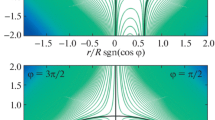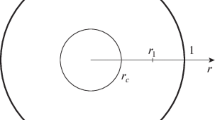Abstract
In order to describe plasma equilibrium near a given magnetic surface, it is sufficient to specify the shape of the surface, the distribution of the magnetic field strength on it, and two profile coefficients (the derivatives of the plasma pressure and current). Geometrically, this means that all the basis vectors of the flux coordinate system should be determined on the magnetic surface. Expressions for these vectors in an invariant basis are obtained. The maximum possible value of the pressure profile coefficient consistent with equilibrium is described by a universal geometric relationship that expresses the limiting value of the torsion of the magnetic field line on the magnetic surface as a function of the curvature of the surface. The relationships obtained are used to show that the stability of a system with closed magnetic field lines is governed by perturbations of the anti-Mercier type.
Similar content being viewed by others
References
F. Bauer, O. Betancourt, and P. Garabedian, Magnetodynamic Equilibrium and Stability in Stellarators (Springer-Verlag, New York, 1984).
A. Boozer, Phys. Plasmas 9, 3762 (2002).
C. C. Hegna, Phys. Plasmas 7, 3921 (2000).
V. D. Pustovitov and V. D. Shafranov, in Reviews of Plasma Physics, Ed. by B. B. Kadomtsev (Énergoat-omizdat, Moscow, 1982; Consultants Bureau, New York, 1987), Vol. 15.
D. Palumbo, Atti Acad. Sci. Lett. Arti Palermo 4, 475 (1983–1984).
A. A. Skovoroda, Fiz. Plazmy 26, 590 (2000) [Plasma Phys. Rep. 26, 550 (2000)].
A. Salat and J. A. Tataronis, J. Geophys. Res. 105, 13 055 (2000).
Yu. A. Aminov, Vector Field Geometry (Nauka, Moscow, 1990) [in Russian].
G. A. Korn and T. M. Korn, Mathematical Handbook for Scientists and Engineers (McGraw-Hill, New York, 1961; Nauka, Moscow, 1971).
A. A. Skovoroda, Fiz. Plazmy 24, 1059 (1998) [Plasma Phys. Rep. 24, 989 (1998)].
A. A. Skovoroda and V. D. Shafranov, Fiz. Plazmy 21, 937 (1995) [Plasma Phys. Rep. 21, 887 (1995)].
G. Grieger, C. D. Beidler, H. Maassberg, et al., in Proceedings of the 13th International Conference on Plasma Physics and Controlled Nuclear Fusion Research, Washington, DC, 1990, Nucl. Fusion (Suppl.) 31, 525 (1991).
V. V. Arsenin, A. V. Zvonkov, and A. A. Skovoroda, Fiz. Plazmy 31, 6 (2005) [Plasma Phys. Rep. 31, 3 (2005)].
C. C. Hegna and N. Nakajama, Phys. Plasmas 5, 1336 (1998).
V. I. Arnold, Mathematical Methods of Classical Mechanics (Nauka, Moscow, 1978; Springer-Verlag, New York, 1989).
Author information
Authors and Affiliations
Additional information
Original Russian Text © A.A. Skovoroda, 2006, published in Fizika Plazmy, 2006, Vol. 32, No. 12, pp. 1059–1069.
Rights and permissions
About this article
Cite this article
Skovoroda, A.A. Geometric properties of plasma equilibrium near a given magnetic surface. Plasma Phys. Rep. 32, 977–987 (2006). https://doi.org/10.1134/S1063780X06120014
Received:
Accepted:
Issue Date:
DOI: https://doi.org/10.1134/S1063780X06120014




